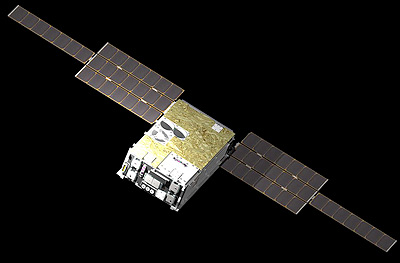Thank you very much for visiting Gunter's Space Page. I hope that this site is useful and informative for you.
If you appreciate the information provided on this site, please consider supporting my work by making a simple and secure donation via PayPal. Please help to run the website and keep everything free of charge. Thank you very much.
EQUULEUS

EQUULEUS [JAXA]
EQUULEUS (Equilibrium Lunar-Earth point 6U Spacecraft) is a small lunar mission designed jointly by the Japan Aerospace Exploration Agency (JAXA) and the University of Tokyo.
It will measure the distribution of plasma that surrounds the Earth to help scientists understand the radiation environment in the region of space around Earth. It will also demonstrate low-energy trajectory control techniques, such as multiple lunar flybys, within the Earth-Moon Lagrangian points (EML).
EQUULEUS is equipped with the AQUARIUS propulsion system consisting of eight water thrusters also used for attitude control and momentum management. The spacecraft will carry 1.5 kg of water, and the complete propulsion system occupies about 2.5 units out of the 6 units total spacecraft volume.
The scientific payload consists of three instruments:
- PHOENIX (Plasmaspheric Helium ion Observation by Enhanced New Imager in eXtreme ultraviolet), a small UV telescope to operate in the high-energy extreme ultraviolet wavelengths. It consists of an entrance mirror of 60 mm diamemeter, and a photon counting device.
- DELPHINUS (DEtection camera for Lunar impact PHenomena IN 6U Spacecraft), a camera connected to the PHOENIX telescope to observe lunar impact flashes and near-Earth asteroids, as well as potential 'mini-moons' while positioned at the Earth-Moon Lagrangian point L2 (EML2) halo orbit.
- CLOTH (Cis-Lunar Object Detector within Thermal Insulation) to detect and evaluate the meteoroid impact flux in the cislunar space by using dust detectors mounted on the exterior of the spacecraft.
EQUULEUS is one of 10 cubesats carried with the Artemis 1 (Orion CM-002) mission into a heliocentric orbit in cis-lunar space on the maiden flight of the SLS (Block 1) iCPS launch vehicle in November 2022.
| Nation: | Japan |
|---|---|
| Type / Application: | Lunar flyby |
| Operator: | JAXA, University of Tokyo |
| Contractors: | JAXA, University of Tokyo |
| Equipment: | PHOENIX, DELPHINUS, CLOTH |
| Configuration: | CubeSat (6U) |
| Propulsion: | AQUARIUS with 8 water thrusters |
| Power: | 2 deployable solar arrays, batteries |
| Lifetime: | |
| Mass: | ~14 kg |
| Orbit: | Lunar fly-by, Earth-Moon Lagrangian points |
| Satellite | COSPAR | Date | LS | Launch Vehicle | Remarks | |
|---|---|---|---|---|---|---|
| EQUULEUS | 2022-156E | 16.11.2022 | CCK LC-39B | SLS (Block 1) iCPS | with Artemis 1 (Orion CM-002), BioSentinel, CuSP, LunaH-Map, Lunar-IceCube, NEA-Scout, LunIR, OMOTENASHI, ArgoMoon, Miles |
